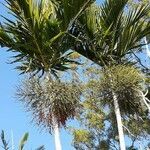A solitary palm which grows to 10 m high. The trunk is slender and grey. It is 7-20 cm across. The trunk has rings along it. The crown-shaft is whitish-green. The leaves are bright green and arching. The leaves are compound. They are 1-2.5 m long. There are 40-60 leaflets which are 50-60 cm long. They are smooth. The fruit is 15-20 mm long. They occur in bunches below the crown-shaft. The fruit are bright red. There is one seed which is about 15 mm long. The flesh of the fruit is edible.
Stems solitary. 2n = 32.


